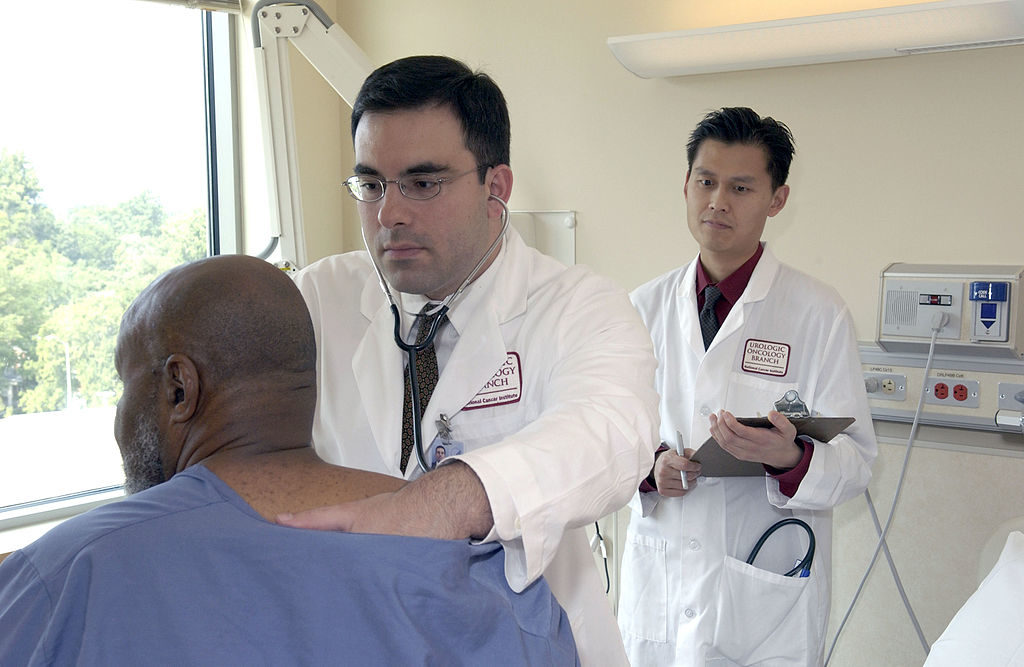A recent study, published in Psychiatric Services, investigates the role of racial bias in the overdiagnosis of schizophrenia in African American patients. By examining discrepancies between the records of white and African American individuals diagnosed with schizophrenia, the researchers found African Americans screened positive for moderately severe to severe depression significantly more than their non-Latino white counterparts.
The researchers suggest that this finding indicates a tendency to privilege reports of psychotic symptoms over mood symptoms in African American patients. This disparity is not only detrimental to the way a person may self-conceptualize while having an incorrect diagnosis, but could also lead to ineffective treatment for a community of people based on their race. The authors, led by Michael A. Gara from Rutgers, write:
“The results are consistent with findings from a large body of literature suggesting that racial differences in the diagnosis of schizophrenia in the United States result in part from clinicians underemphasizing the relevance of mood symptoms among African Americans compared with other racial-ethnic groups.”

Although contradictory to epidemiology surveys, the diagnosis of schizophrenia is more prominent among African Americans compared with other ethnic groups in the United States. The reasons behind racial discrepancies in diagnosis rates may be attributable to biological and social environmental factors, but the problem has not been thoroughly investigated.
Previous studies by Strakowski, a coauthor on this study, have hypothesized that “racial bias in the diagnosis of schizophrenia spectrum disorders in part results from clinicians’ overemphasizing the relevance of psychotic symptoms to relative to mood symptoms among African Americans, compared with other racial or ethnic groups.”
For example, one study juxtaposes the reports of diagnosticians blinded to the individual’s race/ethnicity to those of unblinded clinician interviewers, the former using the same transcripts but with the racial cues eliminated. The unblinded clinicians assessed more first-rank psychotic symptoms among African Americans than white people than the blinded assessors, displaying a bias towards emphasizing psychotic symptoms for those assessors exposed to racial indicators.
Intending to extend the work of these prior studies into a more extensive clinical system, the authors aim to “determine whether clinicians failed to effectively weigh mood symptoms when diagnosing schizophrenia or schizoaffective mood disorder among African Americans. The team examined electronic medical records of 1,657 patients at Rutgers University Behavioral Health Care community outpatient clinic to compare the proportion of African American and non-Latino white individuals diagnosed as having schizophrenia or schizoaffective disorder with concurrent positive screens for major depression.
“As hypothesized, we found that among individuals diagnosed as having schizophrenia, African Americans were significantly more likely than non-Latino whites to screen positive for moderately severe to severe depression. This effect was not found for schizoaffective disorder and appeared to be limited to schizophrenia, presumably because an appreciation of mood symptoms is built into the diagnosis of schizoaffective disorder,” write Gara and colleagues.
The results were congruent with Strakowski and colleagues’ previous studies, while the likely complex underpinnings for misdiagnosis warrants further evaluation. The authors suggest possible historical factors like a “conscious or unconscious bias toward the meaning of psychiatric symptoms of African Americans or the effects on the clinical presentation of being a patient from a racial-ethnic minority group.”
The risk of serious consequences from an inaccurate diagnosis due to the factor of underemphasizing mood symptoms include:
- Ineffective treatments that can produce “prolonged patient frustration, treatment nonadherence or dropout, delays in treatment response, and worsening morbidity and suicide.”
- Lower treatment expectations and “inadequate depth and breadth of therapeutic interventions.”
- Inappropriate prescription of antipsychotic medications and their side effects, for example, “metabolic syndrome, weight gain, diabetes, and movement disorders.”
This study contributes to another explanation in the documented overdiagnosis of schizophrenia in the African American community. Incorporating routine screening for major depression in appropriate clinical sites is suggested to reduce racial inequalities in schizophrenia diagnoses and promote more personalized treatment.
While this study suggests ways to reduce bias through routine screening, it lacks alternative ideas to reducing bias such as within the clinicians themselves. Lastly, because the authors did not have access to measures of poverty, discrimination, and nutrition of the population, nor access to data surrounding clinician ratings of psychotic symptoms, among others, more studies are encouraged to include these factors and larger contextual possibilities.
****
Gara, M. A., Minksy, S., Silverstein, S. M., Miskimen, T., Strakowski, S. M. (2019). A naturalistic study of racial disparities in diagnoses at an outpatient behavioral health clinic. Psychiatric Services 70, 130–134. doi: 10.1176/appi.ps.201800223 (Link)















Actually, these “diagnostic” techniques lead to both groups getting improper treatments, the “white” guys getting antidepressants until the sudden revelations from God and/or the devil, demonstrate the erroneous diagnosis, while the colored guys become twitching robots from their maltreatment, demonstrating exactly the same thing.
Report comment
Schizoaffective or schizophrenia? So, there seems to be at least one biological exam psychiatry has at it’s disposal now. Measure the darkness of the patients skin. Or is it just unintended bias? Makes you wonder what psychiatrists are evaluating when they are “observing appearance”.
Report comment
Darkness of skin, the presence of boobs, poor fashion sense, liking cats when the shrink’s a dog person..All signs of serious mental illness. 😛
Report comment
if you have $$$$$$$$you can get any
diagnosis you want or desire or need…
Report comment
“Schizophrenia” was once a middle(ish) class white woman’s disease…in the 50s. Then, it became more of an antiauthoritarian, even just misfit “disorder…”
non-whites, people involved in the counterculture or youth culture, women who didn’t know their place, drop outs…
and, of course, now…the same profession that once labeled enslaved human beings with ‘drapetomania’ when they tried to flee to freedom, is labeling those who are low status with ‘schizophrenia,’ which is basically a way of turning distressed human beings in psychiatric slaves. and then those who question the labels are burdened with additional labels, more force, more toxic drugs, more confinement…
“Schizophrenia”=invalidation=psychiatric slavery. The rare exceptions to the rule–Elyn Saks, I think is her name, comes to mind…-prove- the rule.
Report comment
I personally witnessed “mental health” workers actively harass, then force drug, a very nice, peaceful, but very large black man named John. I’m sure they did it to intimidate all of us, but it was blatant racism, and morally repugnant behavior on the part of the “mental health” workers. John had done nothing wrong.
Report comment
see book from 2010
The Protest Psychosis: How SCZ became a black disease by J. Metzl
https://www.psychiatrictimes.com/film-and-book-reviews/review-%E2%80%93-protest-psychosis-how-schizophrenia-became-black-disease
https://en.wikipedia.org/wiki/The_Protest_Psychosis
Report comment
All psychiatric “diagnoses” constitute hate speech.
Report comment
In the DSM 5 we have this: “pedophilic disorder”. Could you clarify why this constitutes hate speech? From whose perspective would you argue?
Report comment
Child molesting is a crime. There’s the legal system for folks who do this stuff.
And by calling those monsters “mentally ill” shrinks insult all the other people they “treat.”
I prefer to call psychiatric labels defamation of character.Once a law abiding citizen receives one he or she is treated worse than a convicted felon. In many ways.
Report comment
I’m not sure what that means. If psychiatry lists pedophilia a disorder, it’s an insult to every other disorder in the DSM? The DSM should only list invalid disorders, or as you say, character traits of otherwise law abiding citizens?
Report comment
An insult to all PEOPLE labeled MI.
Not sure I understand what you’re saying either.
Does someone who experienced a bad reaction to anafranil deserve to be lumped in with child molesters and serial killers? Once women in my church found out about my “diagnosis” they tried to make me quit teaching Sunday school. Since the “severely mentally ill” hurt children according to shrinks.
Report comment
I disagree with this article that labeling ANYONE hopelessly insane and chemical lobotomies will help them.
Btw, I highly recommend Peter Breggins’s Youtube videos on “The Violence Initiative.” A very underhanded attempt to lower birth rates among POC (eugenics) by aggressively “treating” young African American men. Our good friend the APA is behind this creepiness. And almost no one is holding them accountable.
Report comment
I find sometimes comic relief helps to put things into perspective:
https://www.youtube.com/watch?v=JBC-9k3y1ew
don’t forget to watch the second part.
Report comment
It seems like therapists or psychiatrists feel they have to be in control of the situation to feel like they are doing their job right, and anyone who is not impressionable enough, and needs more listening to than is comfortable for the psychiatrist, will just get a label. It ends the conversation, and puts the psychiatrist back in control.
Report comment
If “schizophrenia” is a chimera to begin with how can it be “over” diagnosed? What is an “acceptable” rate of “diagnosis”?
Report comment
Overdiagnosed means that it is received by people who do not hear voices (if such people exist, and voices is not a metaphor of sensitive hearing).
Report comment
You miss the point. All “diagnoses” are invalid by definition.
Report comment
I do not agree, I was in the hospital and saw a person who has real schizophrenia (one in 80 people), he had exactly the same psychosis as I had after cannabis, but he did not use anything, he was born like this.
As for the voices, I know that if you are under stress and doesn’t sleep and eat enough, and especially if you smoke a lot of cigarettes then suddenly thoughts can arise, and it can be called voices, conditionally.
Report comment
How do you know he was ‘born like this?’ You are assuming a lot here.
Report comment
He told me that he has been seen by doctors since childhood, let’s not get lost in three trees, he has spontaneous psychoses (for real, i saw it).
This is the what real schizophrenia is. Communicating with him was not easy.
Report comment
I hear voices–but it’s by choice. I write fiction and work out bits of dialogue between writing sessions.
That man might have benefited from the Hearing Voices Movement. Psychiatry obviously wasn’t helping him if he’d been in “treatment” since he was a child.
Report comment
As i told suddenly arised thoughts can be a symptom of stress and anxiety, it’s not a symptom of schizophrenia. Schizophrenia is a chronic psychosis, which exist.
As for man – he feels well, even married, he does not feel any discomfort in the hospital and takes it for granted.
Report comment
Schizophrenia.. it’s complicated.
RIP BTW
https://www.madinamerica.com/2017/09/concept-schizophrenia-coming-end-heres/
Report comment
The lack of objectivity of these “diagnoses” makes the concept of “overdiagnosis” essentially meaningless, as there is no way to ever tell what the “correct” rate of diagnosis should be.
Report comment
When you use the word “if”, it seems to suggest your really not quite sure. Just trying to drum up support for the next “revelation”.
Report comment
I suggested that voices is a metaphor of sensitive hearing (in psychosis) or suddenly arised thoughts (in anxiety). But i’m not quite sure.
Report comment
Maybe there are people who really hear voices, like someone talking.
Report comment
Ignoring psychiatric diagnosis and taking a page from evolutionary psychology which hypothesises that in relation to “mania” and “depression”:
The homeostasis of the group is achieved at the expense of mood change in the individual.
(longer explanation here: https://tinyurl.com/y3q32qps).
Evolutionary psychology implies genetic origins, however it is not suggesting – as psychiatry does – that a faulty gene in an individual has been passed down via a family line, but rather that a genetic predisposition exists in everyone to experience or get stuck in these states. They are functional in relation to the survival of the species, not the individual.
And as one would expect from this function, the states of “schizophrenia” or “bipolar disorder” are entirely contextual. They include individual factors such as childhood trauma and personality styles, and social factors such as economic status and societal responses to ethnic groups or marginalised communities.
It has been said that there’s a fair degree of overlap between manic depression and schizophrenia, and the common element is loneliness (as experienced as opposed to “being alone”).
In introverted individuals or individuals in an environment where expression is suppressed due to being part of a marginalised culture, on might expect to see symptoms of isolation without expression, currently lumped together within “schizophrenia”.
In more middle-class and privileged environments one might see more changing of rank, or at least more opportunity and possibility for a change in rank, and here one could expect to see drives to change self esteem. Mood change is the only rapid method of changing self-esteem, and hence a more episodic and hierarchical form of distress would naturally result: “bipolar”.
This is only a theory, and one from a particular viewpoint, and it should not deter from the fact that schizophrenia might well be over-diagnosed in marginalised communities. It gets the worst response: mega-doses of “antipsychotics” (aka neuroleptics = literally “brain disabler”), and is by far the most stigmatised.
But as people have been saying here: any “diagnosis” aka lumping an individual person – devoid of context – into a clustered group of diverse behavioural symptoms is badly motivated and asking for – perhaps even intending – bad outcomes.
More:
Territory, Rank and Mental Health: The History of an Idea – John S. Price, Russell Gardner, Daniel R. Wilson, Leon Sloman, Peter Rohde, Mark Erickson, 2007
https://journals.sagepub.com/doi/full/10.1177/147470490700500305
Report comment
“Lumping an individual person…into a clustered group of diverse behavioral symptoms is badly motivated and asking for–perhaps even INTENDING–bad outcomes.”
It probably is intentional. Helpless and dependent lifelong consumers is a great business model.
Report comment
sadly…i think you are correct, rachel.
ive seen what i believe to be the deliberate destruction of human beings by ‘experts’ paid to help. after coming to mia for a while, i understand that happens, but…even now, the sheer level of cruelty and malice, all while pretending to “only want to help,” etc.
Report comment
Thanks. But the original quote comes from Simon. 🙂
Report comment
Perhaps a more appropriate heading and subject would be The Role of Bias in Diagnosis. Currently psychiatry has a few tricks to keep the diagnosis rate of schizophrenia at a consistant 1 % level. One is the bipolar disorder diagnosis that has taken off, and in a few years time, outdistanced in percentages the schizophrenia diagnosis rate. The other is that mood disorder grab bag between schizophrenia and bipolar disorder, schizoaffective disorder. It represents yet another release valve to keep the schizophrenia rate constant. Stars, geniuses, and celebrities get bipolar affective disorder pretty regularly. Schizoaffective disorder is not seen as so likely to result in negative outcomes as pure head-on straightforward schizophrenia, which leaves you schizophrenia as the throw away category of pretty much 1 %, and as Hollywood always knew, when it comes to leading roles in the white entertainment business, members of the circling savage hoard are always more expendable than those in the wagon train, and rescuing army.
Report comment
Frank,
As far as I know Long term Mental Health Disability in the UK is at about 5% of the population.
1 in 20 Adults are claiming Severe Mental Illness Benefit in the UK.
Report comment
“Bipolar” is more lucrative than “schizophrenia.” For Dr. Quackenbush and his twin brother Mr. Quackenbush the CEO of Phake–the major pharmaceutical company.
“Schizophrenia” usually only requires one drug. Though they tend to add on more. (It’s shrinks we’re talking about!) “Bipolar” requires at least 3 drugs. An SSRI, a neuroleptic, and a sedative. Though they may do 5 or 6 or more.
If you could force or con someone into buying 3 drugs or 1 which would you choose? (Assuming you didn’t have a conscience.)
Report comment
I think UK Research should focus on the “Creation of “Schizophrenia”” in the majority of Black People (9 out of 10) originally misdiagnosed with “Schizophrenia”, and subsequently exposed to Strong Psychiatric Drugs.
A UK Black person is more than 10 times more likely to be diagnosed with “Schizophrenia” than a white person in the the UK. And many more times more likely again, to be diagnosed with “Schizophrenia” than a black person in the Caribbean.
(At 10 times the National Average, UK University Kings College (I believe) were considering researching as to why “Rates of Schizophrenia” were so high in Black people in the UK).
Report comment
I believe Genuine Research into this Area would identify Serious Failings in the UK Justice System, and the “Creation of Severe Mental Illness” through exposure to Strong Psychiatric Drugs.
With the Removal of “Schizophrenia” most people could make Full Recovery.
Report comment